The Bullnose Ford F-Series Trucks

1980-1986 F150, F250, F350, and Broncos Find a New Generation of Enthusiasts
For decades now, Ford F-Series trucks have been the best-selling trucks for personal and professional use, outselling all of its main competitors combined. In some years, the F150 wasn’t just the best-selling truck in the US; it was the best-selling vehicle. With this kind of history, it’s no wonder that classic F150s, F250s, and F350s are still relatively easy to find. Whether they are “affordable” when you find them, is another thing.
OBS Fords and the Bullnose
From 1980 to 1996 Ford went through several minor and major overhauls to the F-Series trucks but they are all referred to as OBS or Old Body Style Fords. OBS is a pretty common nickname that many people in the Ford family of enthusiasts are familiar with. The generations within the whole OBS family of trucks have sub-nicknames based on the style of the front grille. This blog is focused on the Bullnose line of Ford trucks which ranges from 1980-1986.
The Bullnose Ford trucks earned this moniker for their subtle but uniquely designed grille and headlights that slant in from the hood down to the bumper. This gives the truck almost a more aggressive or moving forward “coming for ya” kinda look.

The Year of the Bullnose (1980 and 1981)
In 1980, the seventh generation F-Series was brought to market. It wasn’t the first Ford truck to be Built Ford Tough but it was the first to proudly proclaim it. It was also the first year that would eventually be called “The Bullnose.” Offering the standard cab and the SuperCab gave Ford fans a couple of options for cab space. Some minor upgrades included a column-mounted ignition cylinder and an interior hood release, making our batteries a little more secure. Much to our chagrin the 4-door Crew Cab was booted to the curb in 1980 but it made way for two new versions of the F-350. We received the first dually "Six-wheeler", giving it a real mean HD appeal, and the first F-350 4x4, combining real form and can-do function in this powerful truck.
In 1981, Ford felt that its bull nose or slanted grille design was a real keeper along with the interior, so they focused on powertrain upgrades. Radial ply tires and halogen bulbs were the next standard add-ons. This put better rubber to the road and brighter headlights leading the way. Had Santa gone Ford Tough, poor Rudolf may have never gotten his shot.
1982 and 1983 Ford F150, F250, and F350: The Year of the Bullnose, Continued.
In 1982, the F-Series made some major minor changes that would stand the test of time. A simpler grille would adorn the front of these trucks and the “F-O-R-D” letters were removed from the hood. The iconic blue oval Ford emblem, which strikes fear in the hearts of GM employees, became the new grille centerpiece and has stayed there for 40-plus years; except on the Ford Raptors. But hey, nobody is perfect I guess. Fender badges also changed to shift away from trim call letters to model displays of F150, F250, F350, and so on. Ford introduced the F250HD this year, as well. This Heavy Duty F250 was a combination of the standard F250 and the exceedingly more powerful F350.
Last marketed in 1979 the 4-door Crew Cab F350 big dawg mean machine made it back into production in 1983. It was only in a single rear wheel configuration for some reason, but they fixed that mistake in later years.
As a result of the additional F-Series options and trim revisions, the Free-Wheeling option package changed to the free-standing XLS trim which was considered the “Sport” package. It was this year that Ford retired an old and decorated soldier from its lineup. The Ford F100 slowly disappeared into the mist, a true pioneer for truck kind. Had it not been for this ACTUAL trailblazer we may have never gotten to the bestselling line of trucks; we know today as the F-Series and Rangers.
1984 to 1986 Old Body Style Ford F-Series Trucks: 7th Generation, Part 3
In 1984, F150, the ½ ton truck in the model line was the smallest F-Series truck available with the retirement of the F-100. This was also the year that Ford Motor Company included the clutch interlocking system that required you to depress the clutch while turning the key to start the truck. This was a safety feature that prevented the vehicle from lunging forward or backward when starting the truck. The other upgrade for this year was galvanized steel and pretreated steel used in the body panels to supposedly help prevent and slow down rusting… Tell that to our rear quarter panels, rusted rocker panels, and roached floorboards. #AmIRight
1985 brought minor changes to the interior of the F-Series trucks; wood grain was an option for top-end trim and some seat design changes took place. The F-350 got its extra wheels back on the crew cab, though. A brushed aluminum nameplate was included on the tailgate between the lights as an aesthetic upgrade on the premium truck lines.
Bronco Graveyard Loves Our OBS Trucks
This is the second post in a series of at least six, where we will also be covering the Brick Nose, Aero Nose, the Bump Side, and the Dent Side. Will we extend the series beyond that? Maybe… Only time will tell. What we do know is that we will continue to bring you quality content on Ford trucks and SUVs that we hope you find entertaining and useful. While you’re here, take a moment to cruise Bronco Graveyard’s products and see how we can help you repair, restore, and upgrade that OBS Ford pickup or Bronco of yours.

